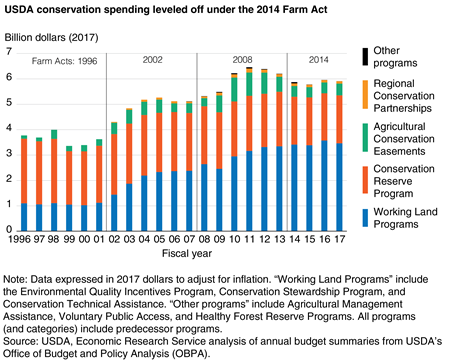Conservation Program Spending Levels Off But Continues Shift to Working Land Programs

USDA agricultural conservation programs provide technical and financial assistance to farmers who adopt and maintain practices that conserve resources or enhance environmental quality. Although USDA implements more than a dozen individual conservation programs, nearly all assistance is channeled through six: the Conservation Reserve Program (CRP), Environmental Quality Incentives Program (EQIP), Conservation Stewardship Program (CSP), Conservation Technical Assistance (CTA), Agricultural Conservation Easement Program (ACEP), and the Resource Conservation Partnership Program (RCPP). EQIP, CSP, and CTA are often referred to as “Working Land Programs” because they focus primarily on supporting conservation on land in agricultural production (crops or grazing).
Adjusted for inflation (in 2017 dollars), conservation spending grew under the 2002 and 2008 Farm Acts but declined slightly under the 2014 Farm Act. The 2014 Farm Act continued to emphasize working land conservation through funding for EQIP, CSP, and CTA. Between fiscal years (FY) 2012 and 2017, combined funding for these programs accounted for more than 50 percent of spending in USDA conservation programs. This emphasis reflects a long-term trend—begun under the 2002 Farm Act—that increased annual spending in Working Land Programs. This spending increased from roughly $1 billion under the 1996 Farm Act to more than $3 billion under the 2014 Act.
Shifts in temporary (10-15 year) land retirement through the CRP also contributed to the decline in overall conservation spending. CRP spending was steady for FY2014 to FY2017 but was lower than at any time since FY1996. CRP acreage peaked in 2007 at 36.4 million acres but declined to 23.4 million acres at the end of FY2017. The effect of lower acreage on overall program cost was partially offset by an increase in the average payment per enrolled acre, from $57 at the end of FY2007 to $77 at the end of FY2017. The increased cost per acre reflects the increasing proportion of enrollment through continuous signup, which tends to enroll practices that require small acreages but yield large environmental benefits per enrolled acre—such as field-edge filter strips, riparian buffers, and grass waterways.
Conservation Programs, by Steven Wallander, USDA, Economic Research Service, September 2023
2014 Farm Act Continues Most Previous Trends In Conservation, by Roger Claassen, USDA, Economic Research Service, May 2014


